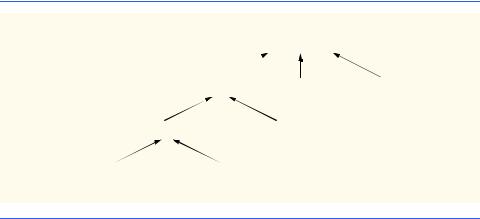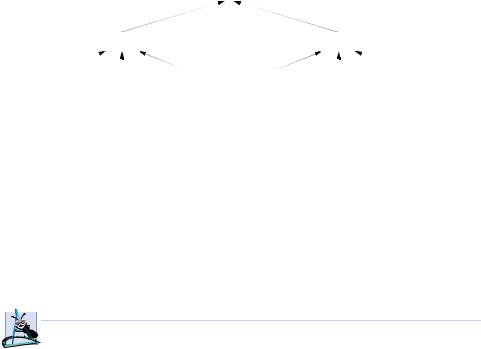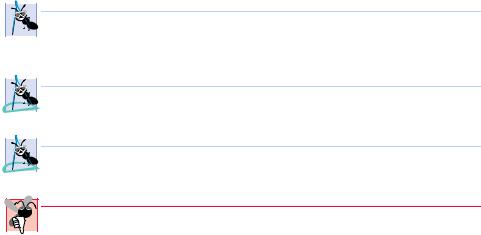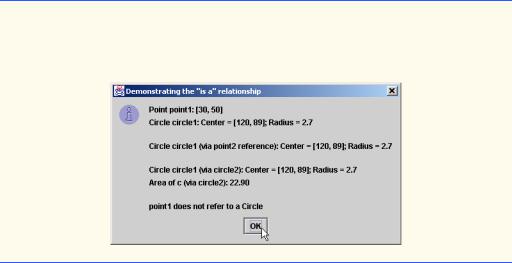
- •Contents
- •Preface
- •Introduction to Computers, the Internet and the Web
- •1.3 Computer Organization
- •Languages
- •1.9 Java Class Libraries
- •1.12 The Internet and the World Wide Web
- •1.14 General Notes about Java and This Book
- •Sections
- •Introduction to Java Applications
- •2.4 Displaying Text in a Dialog Box
- •2.5 Another Java Application: Adding Integers
- •2.8 Decision Making: Equality and Relational Operators
- •Introduction to Java Applets
- •3.2 Sample Applets from the Java 2 Software Development Kit
- •3.3 A Simple Java Applet: Drawing a String
- •3.4 Two More Simple Applets: Drawing Strings and Lines
- •3.6 Viewing Applets in a Web Browser
- •3.7 Java Applet Internet and World Wide Web Resources
- •Repetition)
- •Class Attributes
- •5.8 Labeled break and continue Statements
- •5.9 Logical Operators
- •Methods
- •6.2 Program Modules in Java
- •6.7 Java API Packages
- •6.13 Example Using Recursion: The Fibonacci Series
- •6.16 Methods of Class JApplet
- •Class Operations
- •Arrays
- •7.6 Passing Arrays to Methods
- •7.8 Searching Arrays: Linear Search and Binary Search
- •Collaboration Among Objects
- •8.2 Implementing a Time Abstract Data Type with a Class
- •8.3 Class Scope
- •8.4 Controlling Access to Members
- •8.5 Creating Packages
- •8.7 Using Overloaded Constructors
- •8.9 Software Reusability
- •8.10 Final Instance Variables
- •Classes
- •8.16 Data Abstraction and Encapsulation
- •9.2 Superclasses and Subclasses
- •9.5 Constructors and Finalizers in Subclasses
- •Conversion
- •9.11 Type Fields and switch Statements
- •9.14 Abstract Superclasses and Concrete Classes
- •9.17 New Classes and Dynamic Binding
- •9.18 Case Study: Inheriting Interface and Implementation
- •9.19 Case Study: Creating and Using Interfaces
- •9.21 Notes on Inner Class Definitions
- •Strings and Characters
- •10.2 Fundamentals of Characters and Strings
- •10.21 Card Shuffling and Dealing Simulation
- •Handling
- •Graphics and Java2D
- •11.2 Graphics Contexts and Graphics Objects
- •11.5 Drawing Lines, Rectangles and Ovals
- •11.9 Java2D Shapes
- •12.12 Adapter Classes
- •Cases
- •13.3 Creating a Customized Subclass of JPanel
- •Applications
- •Controller
- •Exception Handling
- •14.6 Throwing an Exception
- •14.7 Catching an Exception
- •Multithreading
- •15.3 Thread States: Life Cycle of a Thread
- •15.4 Thread Priorities and Thread Scheduling
- •15.5 Thread Synchronization
- •15.9 Daemon Threads
- •Multithreading
- •Design Patterns
- •Files and Streams
- •16.2 Data Hierarchy
- •16.3 Files and Streams
- •Networking
- •17.2 Manipulating URIs
- •17.3 Reading a File on a Web Server
- •17.4 Establishing a Simple Server Using Stream Sockets
- •17.5 Establishing a Simple Client Using Stream Sockets
- •17.9 Security and the Network
- •18.2 Loading, Displaying and Scaling Images
- •18.3 Animating a Series of Images
- •18.5 Image Maps
- •18.6 Loading and Playing Audio Clips
- •18.7 Internet and World Wide Web Resources
- •Data Structures
- •19.4 Linked Lists
- •20.8 Bit Manipulation and the Bitwise Operators
- •Collections
- •21.8 Maps
- •21.9 Synchronization Wrappers
- •21.10 Unmodifiable Wrappers
- •22.2 Playing Media
- •22.3 Formatting and Saving Captured Media
- •22.5 Java Sound
- •22.8 Internet and World Wide Web Resources
- •Hexadecimal Numbers

Chapter 9 |
Object-Oriented Programming |
449 |
libraries and can take advantage of other libraries available worldwide. Someday, most software might be constructed from standardized reusable components, just as hardware is often constructed today. This will help meet the challenges of developing the ever more powerful software we will need in the future.
9.2 Superclasses and Subclasses
Often an object of one class “is an” object of another class as well. A rectangle certainly is a quadrilateral (as are squares, parallelograms and trapezoids). Thus, class Rectangle can be said to inherit from class Quadrilateral. In this context, class Quadrilateral is a superclass, and class Rectangle is a subclass. A rectangle is a specific type of quadrilateral, but it is incorrect to claim that a quadrilateral is a rectangle (the quadrilateral could be a parallelogram). Figure 9.1 shows several simple inheritance examples of superclasses and potential subclasses.
Inheritance normally produces subclasses with more features than their superclasses, so the terms superclass and subclass can be confusing. There is another way, however, to view these terms that makes perfectly good sense. Because every subclass object “is an” object of its superclass, and because one superclass can have many subclasses, the set of objects represented by a superclass is normally larger than the set of objects represented by any of that superclass’s subclasses. For example, the superclass Vehicle represents in a generic manner all vehicles, such as cars, trucks, boats, bicycles and so on. However, subclass Car represents only a small subset of all the Vehicles in the world.
Inheritance relationships form tree-like hierarchical structures. A superclass exists in a hierarchical relationship with its subclasses. A class can certainly exist by itself, but it is when a class is used with the mechanism of inheritance that the class becomes either a superclass that supplies attributes and behaviors to other classes or a subclass that inherits those attributes and behaviors. Frequently, one class is both a subclass and a superclass.
Superclass |
Subclasses |
|
|
Student |
GraduateStudent |
|
UndergraduateStudent |
Shape |
Circle |
|
Triangle |
|
Rectangle |
Loan |
CarLoan |
|
HomeImprovementLoan |
|
MortgageLoan |
Employee |
FacultyMember |
|
StaffMember |
Account |
CheckingAccount |
|
SavingsAccount |
Fig. 9.1 Some simple inheritance examples in which the subclass “is a” superclass.
© Copyright 1992–2002 by Deitel & Associates, Inc. All Rights Reserved. 7/7/01

450 |
Object-Oriented Programming |
Chapter 9 |
Let us develop a simple inheritance hierarchy. A typical university community has thousands of people who are community members. These people consist of employees, students and alumni. Employees are either faculty members or staff members. Faculty members are either administrators (such as deans and department chairpersons) or teaching faculty. This yields the inheritance hierarchy shown in Fig. 9.2. Note that the inheritance hierarchy could contain many other classes. For example, students can be graduate students or undergraduate students. Undergraduate students can be freshman, sophomores, juniors, and seniors. And so on. The arrows in the hierarchy represent the “is a” relationship. For example, based on this class hierarchy that we can state, “an
Employee is a CommunityMember,” or “a Teacher is a Faculty member.” CommunityMember is the direct superclass of Employee, Student and Alumni.
CommunityMember is an indirect superclass of all the other classes in the hierarchy diagram. Note that class Employee is both a subclass of CommunityMember and a superclass of Faculty and Staff.
Also, starting from the bottom of the diagram, you can follow the arrows and apply the is a relationship all the way up to the topmost superclass in the hierarchy. For example, an Administrator is a Faculty member, is an Employee and is a CommunityMember. And, in Java, an Administrator also is an Object because all classes in Java have Object as one of their direct or indirect superclasses. Thus, all classes in Java are related in a hierarchical relationship in which they share the 11 methods defined by class Object, which include the toString and finalize methods discussed previously. Other methods of class Object are discussed as they are needed in the text.
Another substantial inheritance hierarchy is the Shape hierarchy of Figure 9.3. There are abundant examples of hierarchies in the real world, but students are not accustomed to categorizing the real world in this manner, so it takes some adjustment in their thinking. Actually, biology students have had some practice with hierarchies. Everything we study in biology is grouped into a hierarchy headed by living things and these can be plants or animals and so on.
To specify that class TwoDimensionalShape is derived from (or inherits from) class Shape, class TwoDimensionalShape could be defined in Java as follows:
CommunityMember
Employee Student Alumni
Faculty Staff
Administrator Teacher
Fig. 9.2 An inheritance hierarchy for university CommunityMembers.
© Copyright 1992–2002 by Deitel & Associates, Inc. All Rights Reserved. 7/7/01

Chapter 9 |
Object-Oriented Programming |
451 |
|
|
|
Shape |
|
|
|
|
TwoDimensionalShape |
ThreeDimensionalShape |
||||||
|
|
|
|
|
|
|
|
|
|
|
|
|
|
|
|
Circle |
Square |
Triangle |
Sphere |
Cube |
Tetrahedron |
||
|
|
|
|
|
|
|
|
|
|
|
|
|
|
|
|
Fig. 9.3 A portion of a Shape class hierarchy.
public class TwoDimensionalShape extends Shape {
...
}
With inheritance, private members of a superclass are not directly accessible from that class’s subclasses. Package access members of the superclass are accessible in a subclass only if both the superclass and its subclass are in the same package. All other superclass members become members of the subclass, using their original member access (i.e., public members of the superclass become public members of the subclass, and protected members of the superclass become protected members of the subclass).
 Software Engineering Observation 9.3
Software Engineering Observation 9.3
Constructors are never inherited—they are specific to the class in which they are defined.
It is possible to treat superclass objects and subclass objects similarly; that commonality is expressed in the attributes and behaviors of the superclass. Objects of all classes derived from a common superclass can all be treated as objects of that superclass.
We will consider many examples in which we can take advantage of this inheritance relationship with an ease of programming not available in non-object-oriented languages such as C.
9.3 protected Members
A superclass’s public members are accessible anywhere the program has a reference to that superclass type or one of its subclass types. A superclass’s private members are accessible only in methods of that superclass.
A superclass’s protected access members serve as an intermediate level of protection between public and private access. A superclass’s protected members may be accessed only by methods of the superclass, by methods of subclasses and by methods of other classes in the same package (protected members have package access).
Subclass methods can normally refer to public and protected members of the superclass simply by using the member names. When a subclass method overrides a superclass method, the superclass method may be accessed from the subclass by preceding the superclass method name with keyword super followed by the dot operator (.). This technique is illustrated several times throughout the chapter.
© Copyright 1992–2002 by Deitel & Associates, Inc. All Rights Reserved. 7/7/01

452 |
Object-Oriented Programming |
Chapter 9 |
9.4 Relationship between Superclass Objects and Subclass Objects
An object of a subclass can be treated as an object of its superclass. This makes possible some interesting manipulations. For example, despite the fact that objects of a variety of classes derived from a particular superclass might be quite different from one another, we can create an array of references to them—as long as we treat them as superclass objects. But the reverse is not true: A superclass object cannot always be treated a subclass object. For example, a Shape is not always a Circle.
However, an explicit cast can be used to convert a superclass reference to a subclass reference. This can be done only when the superclass reference is referencing a subclass object; otherwise, Java will indicate a ClassCastException—an indication that the cast operation is not allowed. Exceptions are discussed in detail in Chapter 14.
Common Programming Error 9.1
Assigning an object of a superclass to a subclass reference (without a cast) is a syntax error.
 Software Engineering Observation 9.4
Software Engineering Observation 9.4
 If an object has been assigned to a reference of one of its superclasses, it is acceptable to cast
If an object has been assigned to a reference of one of its superclasses, it is acceptable to cast  that object back to its own type. In fact, this must be done in order to send that object any of its messages that do not appear in that superclass.
that object back to its own type. In fact, this must be done in order to send that object any of its messages that do not appear in that superclass.
Our first example consists of two classes. Figure 9.4 shows a Point class definition. Figure 9.5 shows a Circle class definition. We will see that class Circle inherits from class Point. Figure 9.6 shows application class InheritanceTest, which demonstrates assigning subclass references to superclass references and casting superclass references to subclass references.
Every applet defined previously has used some of the techniques presented here. We now formalize the inheritance concept. In Chapter 3, we stated that every class definition in Java must extend another class. However, notice in Fig. 9.4 that class Point (line 4) does not use the extends keyword explicitly. If a new class definition does not extend an existing class definition explicitly, Java implicitly uses class Object (package java.lang) as the superclass for the new class definition. Class Object provides a set of methods that can be used with any object of any class.
 Software Engineering Observation 9.5
Software Engineering Observation 9.5
 Every class in Java implicitly extends Object, unless it is specified otherwise in the first
Every class in Java implicitly extends Object, unless it is specified otherwise in the first  line of the class definition, in which case the class indirectly extends Object. Thus, class Object is the superclass of the entire Java class hierarchy.
line of the class definition, in which case the class indirectly extends Object. Thus, class Object is the superclass of the entire Java class hierarchy.
Let us first examine the Point class definition (Fig. 9.4). The public services of class Point include methods setPoint, getX, getY, toString and two Point constructors. The instance variables x and y of Point are specified as protected. This prevents clients of Point objects from accessing the data directly (unless they are classes in the same package), but enables classes derived from Point to access the inherited instance variables directly. If the data were specified as private, the nonprivate methods of Point would have to be used to access the data, even by subclasses. Note that class Point’s toString method overrides the original toString method inherited from class Object.
© Copyright 1992–2002 by Deitel & Associates, Inc. All Rights Reserved. 7/7/01

Chapter 9 |
Object-Oriented Programming |
453 |
1// Fig. 9.4: Point.java
2 // Definition of class Point
3
4public class Point {
5 protected int x, y; // coordinates of Point
6
7 // No-argument constructor
8public Point()
9{
10// implicit call to superclass constructor occurs here
11setPoint( 0, 0 );
12}
13
14// constructor
15public Point( int xCoordinate, int yCoordinate )
16{
17// implicit call to superclass constructor occurs here
18setPoint( xCoordinate, yCoordinate );
19}
20
21// set x and y coordinates of Point
22public void setPoint( int xCoordinate, int yCoordinate )
23{
24x = xCoordinate;
25y = yCoordinate;
26}
27
28// get x coordinate
29public int getX()
30{
31return x;
32}
33
34// get y coordinate
35public int getY()
36{
37return y;
38}
39
40// convert into a String representation
41public String toString()
42{
43return "[" + x + ", " + y + "]";
44}
45
46 } // end class Point
Fig. 9.4 Point class definition.
Class Point’s constructors (lines 8–12 and 15–19) must call class Object’s constructor. In fact, every subclass constructor is required to call its direct superclass’s constructor as its first task, either implicitly or explicitly (the syntax for this call is discussed with class Circle momentarily). If there is no explicit call to the superclass constructor,
© Copyright 1992–2002 by Deitel & Associates, Inc. All Rights Reserved. 7/7/01

454 |
Object-Oriented Programming |
Chapter 9 |
Java automatically attempts to call the superclass’s default constructor. Note that lines 10 and 17 are comments indicating where the call to the superclass Object’s default constructor occurs.
 Software Engineering Observation 9.6
Software Engineering Observation 9.6
 Every subclass constructor must call one of the direct superclass constructors explicitly or
Every subclass constructor must call one of the direct superclass constructors explicitly or  implicitly. Implicit calls can be made only to the no-argument constructor of the superclass. If the superclass does not provide a no-argument constructor, all direct subclasses of that class must call one of superclass’s constructors explicitly.
implicitly. Implicit calls can be made only to the no-argument constructor of the superclass. If the superclass does not provide a no-argument constructor, all direct subclasses of that class must call one of superclass’s constructors explicitly.
Class Circle (Fig. 9.5) inherits from class Point as specified with the extends keyword on line 4. Keyword extends in the class definition indicates inheritance. All the (nonprivate) members of class Point (except the constructors) are inherited into class Circle. Thus, the public interface to Circle includes the Point class’s public methods as well as the two overloaded Circle constructors and Circle methods setRadius, getRadius, area and toString. Notice that method area (lines 38–41) uses predefined constant Math.PI from class Math (package java.lang) to calculate the area of a circle.
1// Fig. 9.5: Circle.java
2 // Definition of class Circle
3
4 public class Circle extends Point { // inherits from Point 5 protected double radius;
6
7 // no-argument constructor
8public Circle()
9{
10// implicit call to superclass constructor occurs here
11setRadius( 0 );
12}
13
14// constructor
15public Circle( double circleRadius, int xCoordinate,
16int yCoordinate )
17{
18// call superclass constructor to set coordinates
19super( xCoordinate, yCoordinate );
20
21// set radius
22setRadius( circleRadius );
23}
24
25// set radius of Circle
26public void setRadius( double circleRadius )
27{
28radius = ( circleRadius >= 0.0 ? circleRadius : 0.0 );
29}
30
Fig. 9.5 Circle class definition (part 1 of 2).
© Copyright 1992–2002 by Deitel & Associates, Inc. All Rights Reserved. 7/7/01

Chapter 9 |
Object-Oriented Programming |
455 |
31// get radius of Circle
32public double getRadius()
33{
34return radius;
35}
36
37// calculate area of Circle
38public double area()
39{
40return Math.PI * radius * radius;
41}
42
43// convert the Circle to a String
44public String toString()
45{
46return "Center = " + "[" + x + ", " + y + "]" +
47 |
|
"; Radius = " + radius; |
48 |
|
} |
49 |
|
|
50 |
} |
// end class Circle |
|
|
|
Fig. 9.5 |
Circle class definition (part 2 of 2). |
|
The Circle constructors (lines 8–12 and 15–23) must invoke a Point constructor to initialize the superclass portion of a Circle object (i.e., variables x and y inherited from Point). The default constructor at lines 8–12 does not call a Point constructor explicitly, so Java automatically calls class Point’s default constructor (defined at line 8 of Fig. 9.4) that initializes superclass members x and y to zeros. If class Point contained only the constructor with arguments (i.e., did not provide a default constructor), a compiler error would occur.
Line 19 in the body of the second Circle constructor explicitly invokes the Point constructor (defined at line 15 of Fig. 9.4) by using the superclass constructor call syntax— keyword super followed by a set of parentheses containing the arguments to the superclass constructor. In this case, the arguments are the values xCoordinate and yCoordinate that are used by the Point constructor to initialize the superclass members x and y). The call to the superclass constructor must be the first line in the body of the subclass constructor. To call the superclass default constructor explicitly, use the statement
super(); // explicit call to superclass default constructor
Common Programming Error 9.2

 It is a syntax error if a super call by a subclass to its superclass constructor is not the first
It is a syntax error if a super call by a subclass to its superclass constructor is not the first  statement in the subclass constructor.
statement in the subclass constructor.
Common Programming Error 9.3

 It is a syntax error if the arguments to a super call by a subclass to its superclass construc-
It is a syntax error if the arguments to a super call by a subclass to its superclass construc-  tor do not match the parameters specified in one of the superclass constructor definitions.
tor do not match the parameters specified in one of the superclass constructor definitions.
A subclass can redefine a superclass method by using the same signature; this is called overriding a superclass method. When that method is mentioned by name in the subclass,
© Copyright 1992–2002 by Deitel & Associates, Inc. All Rights Reserved. 7/7/01

456 |
Object-Oriented Programming |
Chapter 9 |
the subclass version is automatically called. We have actually been overriding methods in every applet in the book. When we extend JApplet to create a new applet class, the new class inherits versions of init and paint (and many other methods). Each time we defined init or paint, we were overriding the original version that was inherited. Also, when we provided method toString for many of the classes in Chapter 8, we were overriding the original version of toString provided by class Object. As we will see in Fig. 9.8, the super reference followed by the dot operator can be used to access the original superclass version of that method from the subclass.
Note that class Circle’s toString method (lines 44–48) overrides the Point class toString method (lines 41–44 of Fig. 9.4). Class Point’s toString method overrides the original toString method provided by class Object. Actually, every class inherits a toString method, because class Object provides the original toString method. This method converts an object of any class into a String representation and is sometimes called implicitly by the program (e.g., when an object is concatenated with a String). Circle method toString directly accesses the protected instance variables x and y that were inherited from class Point. Method toString uses the values of x and y as part of the Circle’s String representation. Actually, if you study class Point’s toString method and class Circle’s toString method, you will notice that Circle’s toString uses the same formatting as Point’s toString for the Point parts of the Circle. Also, recall Software Engineering Observation 8.14, indicating that, if a method exists that performs part of another method’s task, call the method. Point’s toString performs part of the task of Circle’s toString. To call Point’s toString from class Circle, use the expression
super.toString()
 Software Engineering Observation 9.7
Software Engineering Observation 9.7
 A redefinition of a superclass method in a subclass need not have the same signature as the
A redefinition of a superclass method in a subclass need not have the same signature as the  superclass method. Such a redefinition is not method overriding; rather, it is an example of method overloading.
superclass method. Such a redefinition is not method overriding; rather, it is an example of method overloading.
 Software Engineering Observation 9.8
Software Engineering Observation 9.8
 Any object can be converted to a String with an explicit or implicit call to the object’s
Any object can be converted to a String with an explicit or implicit call to the object’s  toString method.
toString method.
 Software Engineering Observation 9.9
Software Engineering Observation 9.9
 Each class should override method toString to return useful information about objects of
Each class should override method toString to return useful information about objects of  that class.
that class.
Common Programming Error 9.4

 It is a syntax error if a method in a superclass and a method in its subclass have the same
It is a syntax error if a method in a superclass and a method in its subclass have the same  signature but a different return type.
signature but a different return type.
The InheritanceTest application (Fig. 9.6) instantiates Point object point1 and Circle object circle1 at lines 18–19 in main. The String representations of each object are assigned to String output to show that they were initialized correctly (lines 21–22). See the first two lines in the output screen capture to confirm this.
© Copyright 1992–2002 by Deitel & Associates, Inc. All Rights Reserved. 7/7/01

Chapter 9 |
Object-Oriented Programming |
457 |
1// Fig. 9.6: InheritanceTest.java
2 // Demonstrating the "is a" relationship
3
4// Java core packages
5 import java.text.DecimalFormat;
6
7// Java extension packages
8 import javax.swing.JOptionPane;
9
10 public class InheritanceTest {
11
12// test classes Point and Circle
13public static void main( String args[] )
14{
15Point point1, point2;
16Circle circle1, circle2;
17
18point1 = new Point( 30, 50 );
19circle1 = new Circle( 2.7, 120, 89 );
21 String output = "Point point1: " + point1.toString() + 22 "\nCircle circle1: " + circle1.toString();
23
24// use "is a" relationship to refer to a Circle
25// with a Point reference
26 |
point2 = circle1; // assigns Circle to a Point reference |
|
27 |
|
|
28 |
output += "\n\nCircle |
circle1 (via point2 reference): " + |
29 |
point2.toString(); |
|
30 |
|
|
31// use downcasting (casting a superclass reference to a
32// subclass data type) to assign point2 to circle2
33circle2 = ( Circle ) point2;
34
35 output += "\n\nCircle circle1 (via circle2): " +
36 circle2.toString();
37
38DecimalFormat precision2 = new DecimalFormat( "0.00" );
39output += "\nArea of c (via circle2): " +
40 |
precision2.format( circle2.area() ); |
41 |
|
42// attempt to refer to Point object with Circle reference
43if ( point1 instanceof Circle ) {
44 |
circle2 = ( Circle ) point1; |
45output += "\n\ncast successful";
46}
47else
48 |
output += "\n\npoint1 does not refer to a Circle"; |
49 |
|
50 |
JOptionPane.showMessageDialog( null, output, |
51 |
"Demonstrating the \"is a\" relationship", |
52 |
JOptionPane.INFORMATION_MESSAGE ); |
53 |
|
|
|
Fig. 9.6 |
Assigning subclass references to superclass references (part 1 of 2). |
© Copyright 1992–2002 by Deitel & Associates, Inc. All Rights Reserved. 7/7/01

458 |
Object-Oriented Programming |
Chapter 9 |
54System.exit( 0 );
55}
56
57 } // end class InheritanceTest
Fig. 9.6 Assigning subclass references to superclass references (part 2 of 2).
Line 26 assigns circle1 (a reference to a subclass Circle object) to point2 (a superclass Point reference). It is always acceptable in Java to assign a subclass reference to a superclass reference, because of the “is a” relationship of inheritance. A Circle is a Point because class Circle extends class Point. Assigning a superclass reference to a subclass reference is dangerous, as we will see.
Lines 28–29 append the result of point2.toString() to output. Interestingly, when point2 is sent the toString message, Java knows that the object really is a Circle, so it chooses the Circle class’s toString rather than the Point class’s toString as you might have expected. This is an example of polymorphism and dynamic binding—concepts we treat in depth later in this chapter. The compiler looks at the preceding expression and asks the question, “Does the data type of the reference point2 (i.e., Point) have a toString method with no arguments?” The answer to this question is yes (per Point’s toString definition on line 41 of Fig. 9.4). The compiler simply checks the syntax of the expression and ensures that the method exists. At execution time, the interpreter asks the question, “What type is the object to which point2 refers?” Every object in Java knows its own data type, so the answer to the question is point2 refers to a Circle object. Based on this answer, the interpreter calls the toString method of the actual object’s data type—class Circle’s toString method. See the third line of the screen capture to confirm this. The two key programming techniques we used to achieve this polymorphism effect are
1.extending class Point to create class Circle, and
2.overriding method toString with the exact same signature in class Point and class Circle.
Line 33 casts point2, which admittedly is referencing a Circle at this time in the program’s execution, to a Circle and assigns the result to circle2 (this cast would be dangerous if point2 were really referencing a Point, as we will soon discuss). Then we use circle2 to append to output the various facts about circle2. Lines 35–36
© Copyright 1992–2002 by Deitel & Associates, Inc. All Rights Reserved. 7/7/01
